|
***In respect
for tradition, no photos of Aboriginal people have been used in this
article***
 Aborigines:
(Indigenous Australians).
Aborigines:
(Indigenous Australians).
Indigenous
Australians migrated from Africa to Asia around 70,000 years ago,
and arrived in Australia around 50,000 years ago.
(5)
Dispersing across the Australian
continent over time, the ancient peoples expanded and differentiated
into hundreds of distinct groups, each with its own language and
culture. Four hundred and more distinct Australian Aboriginal
groups have been identified across the continent, distinguished by
unique names designating their ancestral languages, dialects, or
distinctive speech patterns.
(4)
The
Australian
Aborigines
represent
the oldest
example of continuous
human
culture in
the world.
The
remarkable
longevity of
their
culture is unique in the modern world, and raises several
fundamental questions about the path that 'Western civilisation' is
currently following.
Quote by: The
Venerable E. Nandisvara Nayake Thero. Dr, PhD.
"To those who judge the degree of a culture by
the degree of its technological sophistication, the
fact that the Australian natives live in the same
fashion now as they did thousands of years ago may
imply that they are uncivilised or uncultured.
However, I would suggest that if a civilization be defined by
the degree of polishing of an individual's mind and the building
of his or her character, and if that culture reflects the
measure of our self-discipline as well as our level of
consciousness, then the Australian Aboriginals are actually one
of the most civilized and highly cultured peoples in the world
today." (1)
The Origins of Australian Aborigines:
In a genetic
study in 2011, researchers found evidence in DNA samples taken
from strands of Aboriginal people's hair, that the ancestors of
the Aboriginal population split off from the ancestors of the
European and Asian populations between 62,000 and 75,000 years
ago - roughly 24,000 years before the European and Asian
populations split off from each other. These Aboriginal
ancestors migrated into South Asia and then into Australia,
where they stayed, with the result that, outside of Africa, the
Aboriginal peoples have occupied the same territory continuously
longer than any other human populations. These findings suggest
that modern Aboriginal peoples are the direct descendants of
migrants who arrived around 50,000 years ago
(3)
Both archaeology and the genes of aboriginal Australians suggest
that a mere 15,000 years were required for humanity to spread from
its initial toehold outside Africa, on the Arabian side of the
straits of Bab el Mandeb, to the Australian continent. The first
Immigrants
thus arrived about 45,000 years ago. A recent study by Irina Pugach of
the Max Planck Institute for Evolutionary Anthropology, in Leipzig,
and her colleagues, which has just been published in the
Proceedings of the National Academy of Sciences,
has apparently resolved the matter. About 4,000 years before
Europeans arrived, it seems that a group of Indian adventurers
(from the same time as the great Indus Valley Civilisation)
chose to call the place home. Unlike their European successors,
these earlier settlers were assimilated by the locals. And they
brought with them both technological improvements and one of
Australia�s most iconic animals, the Dingo.
(2)
(More
about the Indus Valley Civilisation)
The Arrival of Europeans:
The first recorded outside contact with Aboriginals
was with Dutch sailors such as William Janszoon and
Dirk Hartog in the early 1600�s. They were
travelling from Holland to the Dutch Colonies in
Indonesia, (the Spice Islands), and decided to leave
the 'Island' alone. Captain Cooks
'discovery' of 'Terra Nullius' (Uninhabited Earth)
was over 100 years later in
1770. It was estimated over 750,000 Aboriginal
people inhabited the island continent in 1788.
(8)
with over 700 languages spoken
(11).
As is seen in many of the European colonisations,
warfare wasn't a necessary strategy for domination as
the locals had no resistance to the deadly viruses
carried by the sailors and convicts such as smallpox,
syphilis and influenza. In less than a year, over half
the indigenous population living in the Sydney Basin had
died from European diseases.
'Every boat that went down the harbour found them
lying dead on the beaches and in the caverns of the
rocks� They were generally found with the remains of
a small fire on each side of them and some water
left within their reach'. (Lieutenant Fowell,
1789).
The
prevailing attitude of the time was that 'indigenous
peoples' were regarded as being soul-less
creatures, closer to animals than people. The American
Indians had already suffered the same disgrace, and
without resistance the following centuries brought about
the almost complete cultural decimation of the
aborigines. In 1804, settlers were authorised to shoot
unarmed Aboriginal people, following which the wholesale
slaughter of Aborigine culture began.
(13)
'I have myself heard a man, educated, and a
large proprietor of sheep and cattle, maintain that there was no
more harm in shooting a native, than in shooting a wild dog. I
have heard it maintained by others that it is the course of
Providence, that blacks should disappear before the white, and
the sooner the process was carried out the better, for all
parties. I fear such opinions prevail to a great extent. Very
recently in the presence of two clergymen, a man of education
narrated, as a good thing, that he had been one of a party who
had pursued the blacks, in consequence of cattle being rushed by
them, and that he was sure that they shot upwards of a hundred.
When expostulated with, he maintained that there was nothing
wrong in it, that it was preposterous to suppose they had souls.
In this opinion he was joined by another educated person
present'. (Bishop Polding, 1845)
In 1920, the
resident population of Aborigines was calculated as low as 60,000,
and by 1940, Europeans composed 99% of Australian population.
(13). In 1967 after a federal referendum on the
topic, Aborigines became citizens and were allowed to vote
in state and federal elections. Recent government statistics
counted approximately 400,000 aboriginal people, or about 2% of
Australia's total population. (9)
(517,000 / 2.5%)
(12)
Descriptions and images of Aboriginal lifestyle at
the time of the European 'arrival' reveals a unique look at the
way humans survived around the ancient world before complex 'civilisations'
became the norm for people living in across the larger Eurasian
continental landmass.
However, in contrast to this system, the Australian Aborigines had
retained the same similar practices, tools, methods etc as were
being found in archaeological digs
from around the ancient world from 50,000 years and before.
The traditional Aboriginal way of life was
nomadic hunter-gathering, with small groups moving around the land
depending on the season and availability of resources. The nomadic
lifestyle has certain restrictions associated with it such as the
number of possessions one can carry, and a strong dependence on
natures harvest but it also restricts the development of industry,
agriculture, townships, cities and many of the most important
foundations upon which complex civilisations are built. The intimate
connectivity with nature and the land is one of the reasons for the
length of their survival, as seen in other similar cultures such as
the North American Indians who bear several striking similarities in
terms of their relationship with the land. The European perception
of Australia as 'Terra Nullius' clearly extended to the Aboriginal
population for a long time as their near annihilation proves.
However, the fact that their culture has existed for such an
incredibly long time has not gone unnoticed by everyone, and our
judgement of their wisdom is now in question as the civilisations of
the modern world are being tested by their veracity for consumption
and greed.
A former professor
of comparative religion at Madras University, as well as director of
the Maha Bodhi Society of Sri Lanka, chief Sanghanayaka of the
Theravada Order of Buddhist monks in India and secretary general of
the World Sangha Council, Dr. Nandisvara had recently returned from
a research expedition with an anthropological team in Australia,
where he had lived for some time with a native Aboriginal community.
In his report, Dr. Nandisvara makes the following statement:
"To those who judge the degree of a culture by
the degree of its technological sophistication, the
fact that the Australian natives live in the same
fashion now as they did thousands of years ago may
imply that they are uncivilized or uncultured. However, I would suggest that if a civilization
be defined by the degree of polishing of an
individual's mind and the building of his or her
character, and if that culture reflects the measure
of our self-discipline as well as our level of
consciousness, then the Australian Aboriginals are
actually one of the most civilized and highly
cultured peoples in the world today."
(1)
Aboriginal Art:
Contemporary
Aboriginal art is typified by 'dotted' painting, a system which was
developed in the 1970's and which became an immediate and lucrative
seller in the international market. It has been suggested that this
type of art was designed as a means of disguising the 'sacred' or
'restricted' parts of their stories, but whatever the truth, it is
now recognised as the dominant modern form of Aboriginal art. In
contrast, the Australian continent is covered with Aboriginal cave
art dating back tens of thousands of years. The oldest art is
currently accepted as being over 28,000 years old.
Article: The Guardian Online. (June, 2012)
'Australia's
Oldest Artwork Found'
'An
archaeologist says he has found the oldest
piece of rock art in Australia and one of
the oldest in the world: an Aboriginal work
created 28,000 years ago in an outback cave.
The dating of one of the thousands of images
in the Northern Territory rock shelter,
known as Nawarla Gabarnmang, will be
published in the next edition of the Journal
of Archaeological Science.
The
archaeologist Bryce Barker, from the
University of Southern Queensland, said he
found the rock in June last year but had
only recently had it dated at the
radiocarbon laboratory of New Zealand's
University of Waikato. He said the rock art
had been made using charcoal, so radiocarbon
dating could be used to determine its age;
most rock art is made with mineral paint, so
its age cannot accurately be measured.
Barker said
the work was "the oldest unequivocally dated
rock art in Australia" and among the oldest
in the world'.
(Link
to Full Article)

The Rock-shelter
known as Nawarla Gabarnmang, shows occupation for over 40,000 years.
The ancient sites which mark the resting place or activity of the supreme
beings in the Dreaming have become special or sacred places. These are the places of
the spirits of creation, where their spirit lives on, totem sites,
with meaning described by the stories for that place, and the place
from which the spirit of the new born child comes. Through the
totemic site an Aboriginal person comes to have identity, an
understanding of his/her relationship with the natural world and
other human beings.
Other Examples of
Aboriginal Art.
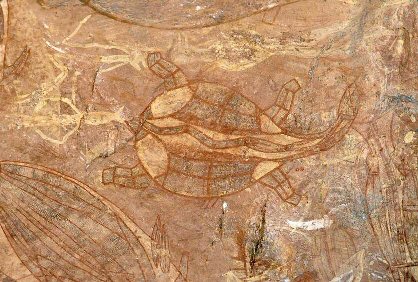
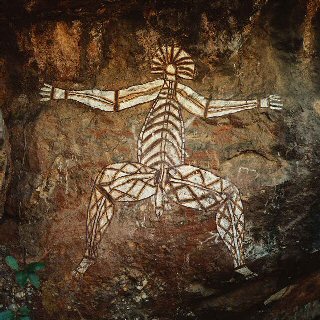
Platypus Totem at
Ubirr (left). Lightning God, Kakadu c. 6,000 BC (right)

Note the
Hand-prints, common in Aboriginal Art, as in Cave-art around the
Palaeolithic world. The European tradition of having missing
fingers is noticeably absent Aboriginal Hand-prints.
For thousands of
years Aborigines have recorded their culture as
rock art.
Their art shows images of the environment, such as the plants and
animals, including images of animals believed to have become extinct
20,000 years ago. For example, in the Wellington Range, the thousands of Aboriginal
artworks adorning cliffs and caves include a painting of the extinct
dog-like creature, the thylacine, made in a style that is at least
15,000 years old. (14)
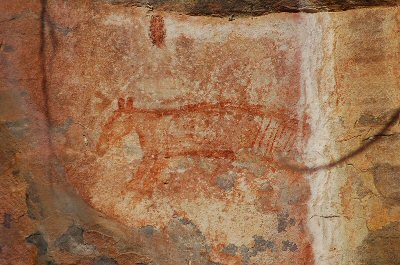
Extinct Thylacine rock art at Ubirr: c. 15,000 BP.
Aboriginal Script.
Although lacking a
formal written language, aboriginal art contains a series of
iconograms with specific meaning. These symbols are included into
paintings which describe events or stories from the dreamtime, and
can be seen as a basic form of language to those who understand
their meaning.
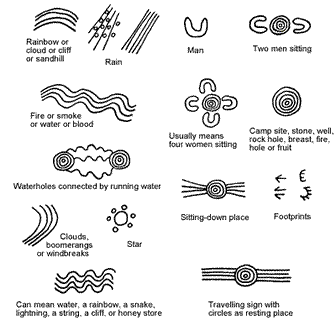
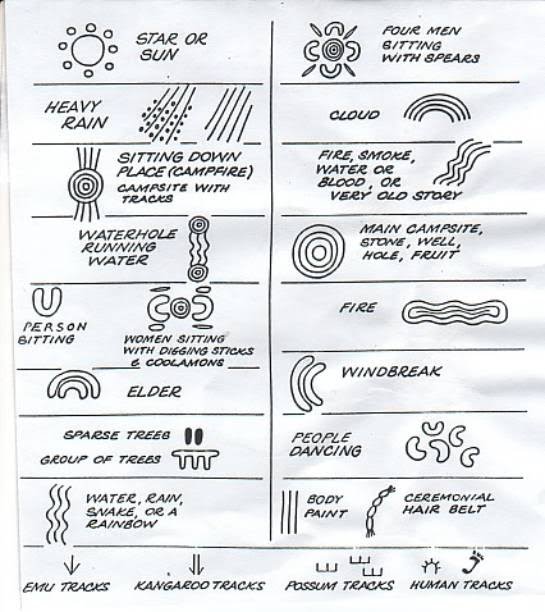
Symbols used in Aboriginal art used
to convey meaning.
Many of these symbols can be seen to
share similarities with the Palaeolithic set of symbols recognised
by Von Petzinger, following her innovative study of common
Palaeolithic symbols in European rock-art.
(More about
Palaeolithic Writing)
(Cave Art Homepage)
Healing:
'In almost all Aboriginal
belief systems, each person has three aspects which make
up his or her whole being. Those are the body, the mind
and the spirit. It is said that for Aboriginal people to
heal from whatever ails them, all aspects of their being
need to be treated�not just one. In that respect, the
Aboriginal belief is in the holistic treatment of the
person. Aboriginal healers, when called upon to minister
to a sick person, do not only administer medicines to
the body, but also conduct spiritual ceremonies for the
spirit and counsel the person to help clear his or her
mind of the effects of the sickness.
In Aboriginal beliefs, if
only the body is treated, then healing cannot take place
properly. If the body becomes ill, then the spirit and
mind also are affected. In the same way, it is believed
that before the body becomes sick, there are often signs
of the impending sickness apparent in the mental or
spiritual status of the person. Preventive steps thus
can be taken by addressing the person�s spiritual needs
early on. Keeping the spirit strong was seen as
practising preventive medicine. Elders, and people who
know of traditional ways of healing, are considered very
important and are respected highly by Aboriginal people.
Some
Aboriginal elders believe that Aboriginal people who are
ill must have all three aspects healed fully in the
Aboriginal way. Some have said that if an Aboriginal
person goes to a non-Aboriginal doctor, then that person
cannot be healed properly in the traditional way, since
traditional healing methods and modern medicine do not
mix. Others believe that if medical doctors are treating
the person�s body, then traditional Aboriginal healers
can and must attend to the treatment of the person�s
mind and spirit. In the same way, if the person is
receiving psychiatric treatment from a psychiatrist,
then his or her physical and spiritual needs still can
be met through traditional healing methods. In this way,
elders believe that there is always room for traditional
methods of healing to take place'.
(7)
(Healing Homepage)
Rituals of Death:
'Sorry Business'.
The
primary traditional burial
practice is to leave the corpse laid
out on an elevated wooden platform, covered in leaves and branches,
and left several months for the flesh to rot away from the bones.
The secondary burial is
when the bones are collected from the platform, painted with red
ochre, and then dispersed. (10)
Some Aborigines bury their dead
some cremate them, some place the bodies on platforms or in trees or
caves to conceal them. Many different practises are performed to
ensure that the spirits of the dead would not cause mischief or
sadness within the language group. In many places mounds of dirt,
bark, sticks and other natural objects were built between the grave
and campsite to ensure that the bad spirits of the dead didn't haunt
the living.
A person's possessions and weapon's are often disposed of or buried
with them during the ceremony. In some areas burial poles are
erected at burial grounds or stencil markings and paintings would
show where loved ones were buried in caves. Ceremonies last days,
weeks and even months depending upon the beliefs of the language
group. During these ceremonies often strict language rules apply.
With close family members restricted to not being able to talk for
the whole period of mourning. Members of the family with the same
name as the deceased were required to change their names.
The tradition not to depict dead people or voice their (first) names
is very old. Traditional law across Australia said that a dead
person�s name could not be said because you would recall and disturb
their spirit. After the invasion this law was adapted to images as
well.
The Origin Myth:
The common
underlying thread of all Aboriginal origin myths is a reference to
the 'Dream-time' or 'creation period'.
At the
beginning of time the earth looked like a featureless, desolate
plain. Nothing existed on the surface.
Baiame, or the Maker of Many Things as
some called him, called the Dreamtime ancestors from under the
ground and over the seas. With them, life came to the barren, flat
plains. Some of the Dreamtime ancestors looked like men or women,
others like the animals or creatures, which descended from them, but
the Dreamtime ancestors could also change their shape from one form
to another.
After emerging from their eternal slumber, the beings � referred to
as totemic ancestors (such as Wallaby Dreaming and Emu
Dreaming etc) � moved about the earth bringing into being the
physical features of the landscape. Mountains, sandhills, plains
and rivers all arose to mark the deeds of the wandering totemic
ancestors. Not a single prominent feature was created which was not
associated with an episode of the supernatural beings.

Biame, the
Awabakal Supreme Being.
For the Awabakal, the supreme being who created their world is
Biame, part human and part kangaroo or wallaby. In a rock cave on
Bulgar Creek near Singleton Biame is depicted in a drawing
approximately eight feet high as if his legs and arms are lying on
the ground (See below). The perpendicular lines drawn under the arms, three on
right and four on the left, represent the seven tribes of the region
for whom this supreme being had great significance: Worimi, Awabakal,
Wonarua, Gamillaroi, Darkinjung, Gringai (Matthews
1893;
Heath 1998). The Dreaming:
The Dreamtime is a widely used, but not
so well
understood term describing the key aspects of Aboriginal spiritual
beliefs and life. It refers not to historical past but a fusion of
identity and spiritual connection with the timeless present. The
Aboriginal concept of time connects past actions and people with
present and future generations. Time is circular, not linear, as
each generation relives the Dreaming activities. There were many myths and rituals connected to both the ancestors and the creators of the world, none of whom ever died but
merged with the natural world and thus remained a part of the
present. These myths and rituals, signifying communion with nature
and the past, were known as the Dreaming or the Dreamtime, and
reflected a belief in the continuity of existence and harmony with
the world.
The term 'Dreaming'
in reference to Aboriginal religious philosophy was adopted by the English anthropologists Spencer and Gillen from their research
published as The Native Tribes of Central Australia (1899). Arrente
elders had endeavoured to explain the basis of their religious
philosophy to them by describing the alcheringa, their religious
philosophy, as the mythic times of the ancestors of the totemic
groups. They had not initially grasped its full meaning and later
Spencer explained that this past mythic time was only a part of the
meaning of alcheringa, that it also meant "dream". Since then it was
commonly adopted by Aboriginal people across Australia that the
ancestral heroes, their past times and everything associated with
them is encapsulated in the English language word "Dreaming". Thus
Aboriginal philosophy comes from the time of creation when the world
was "mixed up" and not at all like it is in modern times.
Supreme beings, great ancestors who were human, animal and bird all
at the same time, anthropomorphs, were powerful enough to create
order in this chaos. These ancestral heroes are responsible for life
itself; life that arose in a time when all the natural species, the
land and humans, were part of the same ongoing life force. They had
powers to turn themselves into geographic or natural features, they
descended into the ground and reappeared as a species of bird or
animal, or as a waterhole, or they ascended into the sky and became
constellations. As they moved around they created all the species,
humans, the landscape and all the features of it, then they tended
to settle down and remain as a feature of the landscape.
(6)
Aboriginal Mythology as a Historical Narrative:
An Australian
linguist,
R. M. W. Dixon, recording Aboriginal myths in their
original languages, encountered coincidences between some of
the landscape details being told about within various myths,
and
scientific discoveries being made about the same landscapes.
In the case of the
Atherton Tableland, myths tell of the origins of
Lake Eacham,
Lake Barrine, and
Lake Euramo. Geological research dated the formative
volcanic explosions described by Aboriginal myth tellers as
having occurred more than 10,000 years ago.
Pollen fossil sampling from the silt which had settled to
the bottom of the craters confirmed the Aboriginal myth-tellers' story.
'It is said that two newly-initiated men broke a taboo
and angered the rainbow serpent Yamany, major spirit of the area ... As a
result 'the camping-place began to change, the earth under the camp roaring
like thunder. The wind started to blow down, as if a cyclone were coming.
The camping-place began to twist and crack. While this was happening there
was in the sky a red cloud, of a hue never seen before. The people tried to
run from side to side but were swallowed by a crack which opened in the
ground'....
After telling the myth, in
1964, the storyteller remarked that when this happened the country round the
lakes was 'not jungle - just open scrub'. In 1968, a dated pollen diagram from
the organic sediments of Lake Euramoo [Ngimun] by Peter Kershaw (1970) showed,
rather surprisingly, that the rain forest in that area is only about 7,600 years
old'. (15)
Further investigation of the material by the Australian
Heritage Commission led to the Crater Lakes myth being
listed nationally on the
Register of the National Estate,
and included within Australia's
World Heritage nomination of the
wet tropical forests, as an "unparalleled human record
of events dating back to the
Pleistocene era."
Since then, Dixon has assembled a number of similar
examples of Australian Aboriginal myths that accurately
describe landscapes of an ancient past. He particularly
noted the numerous myths telling of previous sea levels,
including:
- The
Port Phillip myth (recorded as told to Robert
Russell in 1850), describing Port Phillip Bay as once
dry land, and the course of the
Yarra River being once different, following what was
then Carrum Carrum swamp. This was an oral history that
accurately described a landscape from 10 000 years ago.
- The
Great Barrier Reef coastline myth (told to Dixon) in
Yarrabah, just south of
Cairns, telling of a past coastline (since flooded)
which stood at the edge of the current Great Barrier
Reef, and naming places now completely submerged after
the forest types and trees that once grew there. This
was an oral record that was accurate for the landscape
10 000 years ago.
- The
Lake Eyre myths (recorded by J. W. Gregory in 1906),
telling of the deserts of
Central Australia as once having been fertile,
well-watered plains, and the deserts around present Lake
Eyre having been one continuous garden. This oral story
matches geologists' understanding that there was a wet
phase to the early
Holocene when the lake would have had permanent
water.
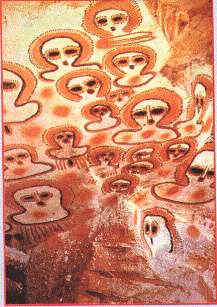 The
Flood Myth: The
Flood Myth:
In
Aboriginal mythology there are beings called the Wondjina. They were
rain spirits who were also involved with creation. They are said to
come from the sky and paint pictures of themselves on cave walls.
At one point in time it is said, the Wondjina were angry at how people were
behaving in the world, so they caused a worldwide flood. This was
caused by them opening their mouths, and when
they did this rain would never cease. After the floods had killed
all the humans, the Wondjina recreated everything.
Obviously the Wondjina had to keep their mouths shut so that the
world wouldn�t flood again. After doing this so long, their mouths
disappeared, which is why in most images of them they have no mouths.
The Wondjina eventually they lost their form and became more like
the spirits that you and I think of. They are said to still exist in
waterholes, ponds.
(Other
Versions of the Great Flood Myth)
The Rainbow Serpent:
The Rainbow
Serpent is a common
motif in the art and mythology of Aboriginal
Australia. There are innumerable names and stories associated with
the serpent, all of which communicate the significance and
power of this being within Aboriginal traditions. The
Rainbow Serpent's mythology is closely linked to
land, water, life, social relationships and
fertility. It is known both as a benevolent protector of its people and as a malevolent
punisher of law breakers.
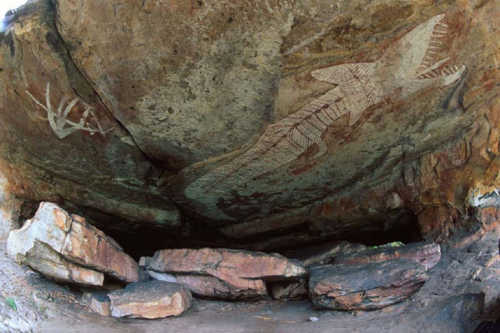
The
Arnhem Rainbow Serpent.
The Rainbow Serpent is seen as the
inhabitant of permanent
waterholes
and is in control of life's most precious
resource, oils and waters. The Rainbow Serpent has been
understood as male by some traditions and female by others.
The sometimes unpredictable Rainbow Serpent (in contrast to
the unyielding Sun) replenishes the stores of water, forming
meandering gullies and deep channels as the Rainbow Serpent slithered
across the landscape.
Dreamtime stories tell of the great spirits and totems
during creation, in animal and human form they moulded the
barren and featureless earth. The Rainbow Serpent came from
beneath the ground and created huge ridges, mountains and
gorges as it pushed upward. The Rainbow Serpent is known as
Ngalyod by the
Gunwinggu and Borlung by the
Miali. The Rainbow Serpent is understood to be of
immense proportions and inhabits deep permanent waterholes.
Serpent stories vary according to
environmental differences. Tribes of the
monsoonal areas depict an epic interaction of the Sun,
Serpent and wind in their
Dreamtime stories, whereas tribes of the central desert
experience less drastic seasonal shifts and their stories
reflect this.
Song Lines:
There are many
different methods of pre-literate navigation that have been
documented around the ancient world. The Aboriginal fusion of
navigation and oral mythological storytelling is likely to have
been a common method in the past and goes a long way to explaining
the development of sacred landscapes.
Song-lines, also called Dreaming tracks, are paths across
the land (or sometimes the sky)
which mark the route followed by localised
'creator-beings' during the
Dreaming. The paths of the Song-lines are recorded in
traditional songs, stories, dance, and painting. By singing the songs in the appropriate sequence,
Indigenous people could navigate vast distances, often
travelling through the deserts of Australia's interior.
The continent of Australia contains an extensive system
of songlines, some of which are of a few kilometres,
whilst others traverse hundreds of kilometres through lands of many
different Indigenous peoples.
A
knowledgeable person is able to navigate across the land
by repeating the words of the song, which describe the
location of landmarks, waterholes, and other natural
phenomena. In some cases, the paths of the
creator-beings are said to be evident from their marks,
or
petroglyphs, on the land, such as large
depressions in the land which are said to be their
footprints.
Since a Song-line can span the lands of several
different language groups, different parts of the song are said to
be in those different languages. Languages are not a barrier because
the melodic contour of the song describes the nature of the land
over which the song passes. The rhythm is what is crucial to
understanding the song. Listening to the song of the land is the
same as walking the Song-line and
observing the land.
In some cases, a song-line has a particular direction,
and walking the wrong way along a song-line may be a
sacrilegious act (e.g. climbing up
Uluru where the correct direction is down).
Traditional Aboriginal people regard the land as sacred,
and the songs must be continually sung to keep the land
"alive".
(Prehistoric
Pacific Islanders)
(Palaeolithic
Wisdom) |








 The
Flood Myth:
The
Flood Myth: